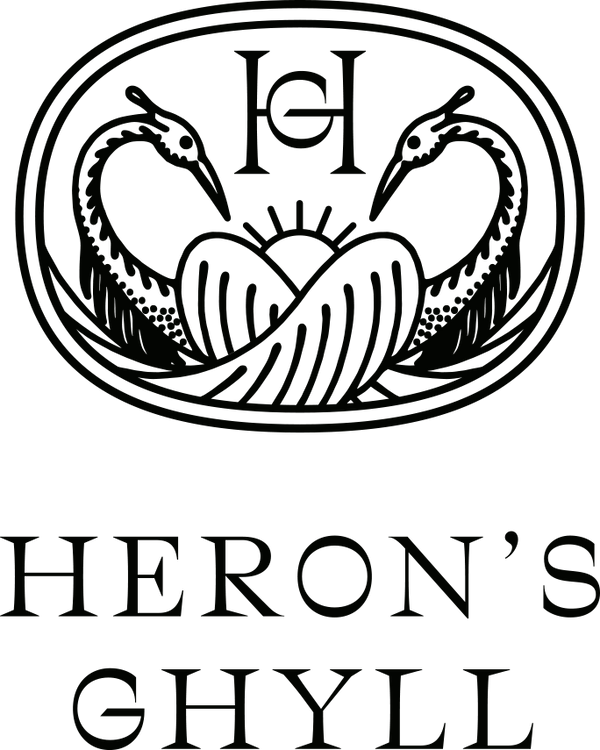
The definitive guide to stand collars
Share
A mandarin collar, a nehru collar, and a grandad collar walk into a bar.
They all stand.
Ha! We’ll be here all week folks.
There seems to be some confusion over the terms ‘mandarin collar’, ‘nehru collar’, ‘stand collar’, and ‘grandad collar’; and since we’re building a brand around alternatives to the lapel, we thought it appropriate to clarify some of the nomenclature around standing collars.

Mandarin collar by Heron’s Ghyll, 2022
What is a stand collar?
‘Stand collar’ is a catchall phrase that encompasses any unfolded collar that stands around the neckline. This includes mandarin collars.
There’s a common misconception that stand collars originated in the ‘East’ and are uniquely Eastern. The truth is that fashion evolved with some degree of parallel across different parts of the globe as a result of the interconnectedness brought about by exploration and trade.

Left: Ayusi, an officer of the Qing Army, late 1700s; Right: John I, King of Portugal, 1435
In Europe, stand collars were popular throughout much of history and class was more of a differentiator when it came to style; for example, simple collarless tunics were worn by those on the bottom rungs while more elaborate high collars were worn by those on top.

Bronzino's Portrait of a Young Man, 1540
To the extent that non-Western men’s fashion is defined by a stand collar, it is only because Western formalwear has become so intertwined with the lapel despite it being a relatively recent invention.
What is a mandarin collar?
These days, the term ‘mandarin collar’ is often used to refer to any unfolded collar that stands around the neckline with a gap at the center front. A mandarin collar originally referred to a high, curve-edged standing collar that derived from the changshan and magua, a shape now seen on contemporary Tang jackets.

Mandarin collar with pankou closure, 19th century
Portuguese merchants first used the word mandarim to refer to a specific class of Chinese scholar-official who represented the interests of the Chinese empire within the Malaccan entrepôt. According to Ungku Abdul Aziz, the word mandarim was a mispronunciation of the Malay word for minister: menteri. The mandarins never actually called themselves ‘mandarins’, it was an external projection onto them by a foreign source. Somehow, this mispronunciation of a word that meant ‘minister’ came to refer to all things Chinese, like mandarin ducks and mandarin oranges.
The idea that a collar—the ‘mandarin’ collar—defines the essence of Chinese dress is an orientalist construct: the Westerner may evolve their fashions and modernize, but the Oriental is stuck with a singular cultural costume embodied by the mandarin collar. Thankfully, this is no longer a view held by most people.
Chinese dress, like Western dress, or fashion anywhere else in the world for that matter, is not static. This site does an excellent job of illustrating how Chinese collars throughout history rose and fell; crossed-over and met at the edges; folded and unfolded; had angular and curved edges; in the same way that ‘Western’ collars did. No one owns a particular collar shape; rather, we share them all.

Mandarin collar on a British Army Officer’s shell jacket, c.1875
What is a mao collar?
The term ‘mao collar’ is sometimes used interchangeably with ‘mandarin collar’, which is surprising. The Business of Fashion’s glossary, for example, states (last accessed 26 April 2022): “Mandarin Collar, or the Mao collar, is a small, close-fitting, stand up collar.” Below is a picture of Chairman Mao in his preferred uniform, the zhongshan suit.

Mao Zedong in a mao collar, 1959
As you can see, the collar, while high, doesn’t even stand. It’s also folded.
What is a nehru collar?

Jawaharlal Nehru in London, 1950 (source)
A survey of the clothing favored by Jawaharlal Nehru seems to indicate a penchant for low stand collars with curved edges. The gradients and angles may be different, but on balance, we think it’s fair to use the terms ‘mandarin collar’ and ‘nehru collar’ interchangeably.
Angular stand collars had resurgent popularity in the U.K. / U.S. in the 1960s and the style was referred to as the Nehru.

Sean Connery as James Bond in Dr. No, 1962

Nehru collars in a Sears catalog, 1968 (source)
What is a grandad collar?
‘Grandad collar’ refers to a banded shirt collar that sits flush against the neck. The collar edges overlap and are secured by a button. The difference between a ‘grandad collar’ and a ‘band collar’ is the use of interfacing in a band collar for an upright shape and a cleaner, more formal finish.
Below, we draw your attention to someone whose personal style we greatly admire: the antiquarian, gallerist, and designer Axel Vervoordt. We might more accurately describe what he’s wearing here as a collarless jacket.

Axel Vervoordt wearing a collarless jacket, 1990s (source)
To conclude, there isn’t a higher authority that decides what is or isn’t a mandarin collar, nor is there one that stipulates how a mandarin collar should or shouldn’t be worn, or who can or cannot wear it.
Clothing evolved, language evolved to describe it, and some of those terms are now outmoded. Ultimately, confusion over terminology shouldn’t detract from one’s enjoyment of something and we hope that we’ve been able to provide a little more clarity around an increasingly popular collar style.

